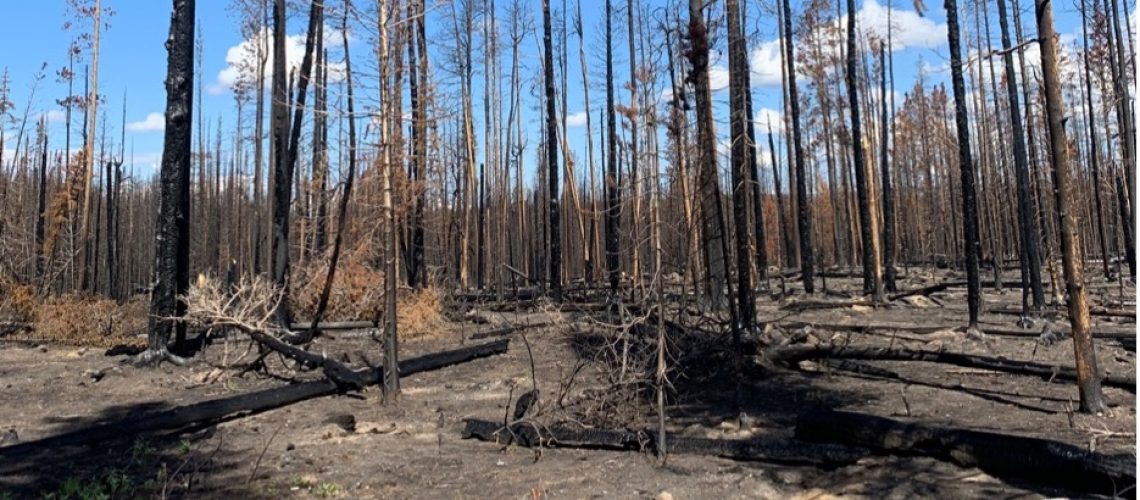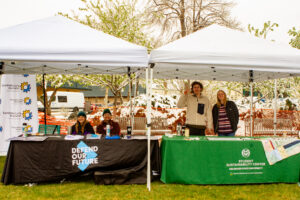Guest Post by Holly Roth, 2021-2022 Sustainability Leadership Fellow, and Ph.D. Candidate in the Department of Chemistry at Colorado State University
Due to many variables, including higher temperatures and extended droughts, fire patterns are changing globally.1,2 In 2020 alone, 46 million acres burned in Australia, and over 10 million acres burned in the United States. Here in Colorado, we experienced the two largest fires on record – Cameron Peak and East Troublesome. With modern fires in the western United States occurring more frequently, at higher severities, and for a longer time period during the year,3,4 there are a lot of questions about the effects this has on water quality and ecosystem health.

United States through mid-century (2041-2070), from Barbero, et. al. 2015.
Understanding the influence of fire on forests is incredibly important because forests provide many valuable benefits for wildlife and humans. For example, forests store about 30-40% of the carbon found on land, improve air quality, and even filter water.5 These services are valued at about $5 trillion per year,6 so when these areas burn it winds up costing us a lot of money. In 2018 alone, it’s estimated that California’s wildfire damages amounted to nearly $149 billion.7
While fire-caused damages to buildings (including homes) and health care costs are fairly straightforward to determine, it’s a lot harder to estimate the damages on an ecosystem level. One major concern following fires are below-ground transformations to the soil. Forest soils provide homes for plant roots and microbes, among other organisms, which work together to break down soils into edible components, especially carbon and nitrogen. During fire, vegetation is consumed, and soil carbon and nitrogen are transformed. The magnitude of these changes is linked to burn severity, or how much material is removed from a soil surface. Higher burn severities generally aren’t as “tasty” for plants or microbes to eat. We can think of these effects the way we might think of a piece of toast – with a little heat (low severity), a plain piece of bread becomes more appetizing. If we heat it for too long though, it becomes burnt and overall a lot less appetizing (high severity). Since fires are increasing in severity, this may have long-term implications for forest recovery.

The changes in soils can typically be seen in fire-affected streams as well. After fire, there is generally an increase in erosion, so burned soils wind up being exported out of their original habitats. This can affect downstream water quality and how we treat that water to make it safe to drink. These effects can have negative impacts on water-dwelling organisms and potentially form carcinogenic byproducts during drinking water disinfection. Because of this, we are really interested in how carbon and nitrogen exported from higher severity fires may impact burned watersheds.
The influence of high burn severity on soils and the export of nutrients from those areas can have profound impacts on the ability of forests to regenerate following fires. This may result in previously forested areas shifting into other types of ecosystems, such as grasslands. Forests are incredibly good at storing carbon, in both soils and plants. When forests burn, that carbon is released into the atmosphere and contributes to greenhouse gases (mostly as carbon dioxide). Normally when a forest regrows after a fire, it’s able to capture that carbon dioxide and store it again. If these forests aren’t able to recover, they may shift from being able to store carbon to being a source of it instead. When that happens, we lose many services that they provide, including their ability to clean our air and water for us. The reasons that a forest may or may not grow back is a key area of climate research, and we hope that learning more about the chemical and biological changes due to fire may help us use our money more wisely and manage forests more effectively.
References
(1) Flannigan, M.; Cantin, A. S.; de Groot, W. J.; Wotton, M.; Newbery, A.; Gowman, L. M. Global Wildland Fire Season Severity in the 21st Century. Forest Ecology and Management 2013, 294, 54–61. https://doi.org/10.1016/j.foreco.2012.10.022.
(2) Westerling, A. L.; Hidalgo, H. G.; Cayan, D. R.; Swetnam, T. W. Warming and Earlier Spring Increase Western U.S. Forest Wildfire Activity. Science 2006, 313 (5789), 940–943. https://doi.org/10.1126/science.1128834.
(3) Barbero, R.; Abatzoglou, J. T.; Larkin, N. K.; Kolden, C. A.; Stocks, B. Climate Change Presents Increased Potential for Very Large Fires in the Contiguous United States. International Journal of Wildland Fire 2015, 24 (7), 892–899. https://doi.org/10.1071/WF15083.
(4) Keyser, A. R.; Westerling, A. L. R. Predicting Increasing High Severity Area Burned for Three Forested Regions in the Western United States Using Extreme Value Theory. Forest Ecology and Management 2019, 432 (October 2018), 694–706. https://doi.org/10.1016/j.foreco.2018.09.027.
(5) Bladon, K. D.; Emelko, M. B.; Silins, U.; Stone, M. Wildfire and the Future of Water Supply. Environmental Science and Technology 2014, 48 (16), 8936–8943. https://doi.org/10.1021/es500130g.
(6) de Groot, R.; D’Arge, R.; Sutton, P.; Grasso, M.; Limburg, K.; Farber, S.; Raskin, R.; van den Belt, M.; Costanza, R.; Hannon, B.; Paruelo, J.; O’Neill, R.; Naeem, S. The Value of the the World’s Ecosystem Services and Natural Capital. Nature 2003, No. 387, 253–260.
(7) Wang, D.; Guan, D.; Zhu, S.; Kinnon, M. mac; Geng, G.; Zhang, Q.; Zheng, H.; Lei, T.; Shao, S.; Gong, P.; Davis, S. J. Economic Footprint of California Wildfires in 2018. Nature Sustainability 2021, 4 (3), 252–260. https://doi.org/10.1038/s41893-020-00646-7.






